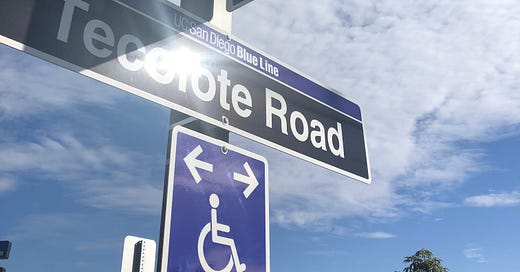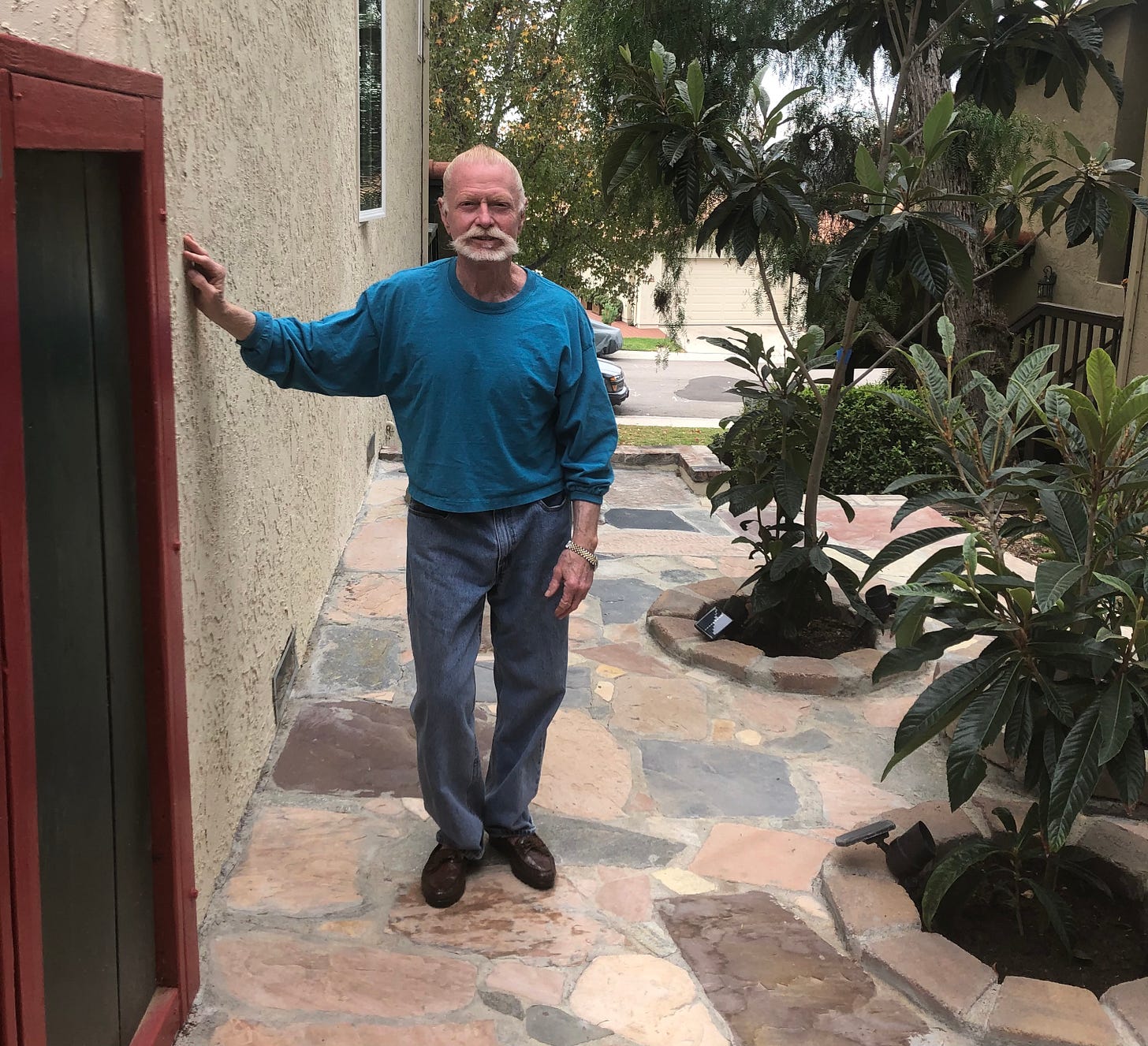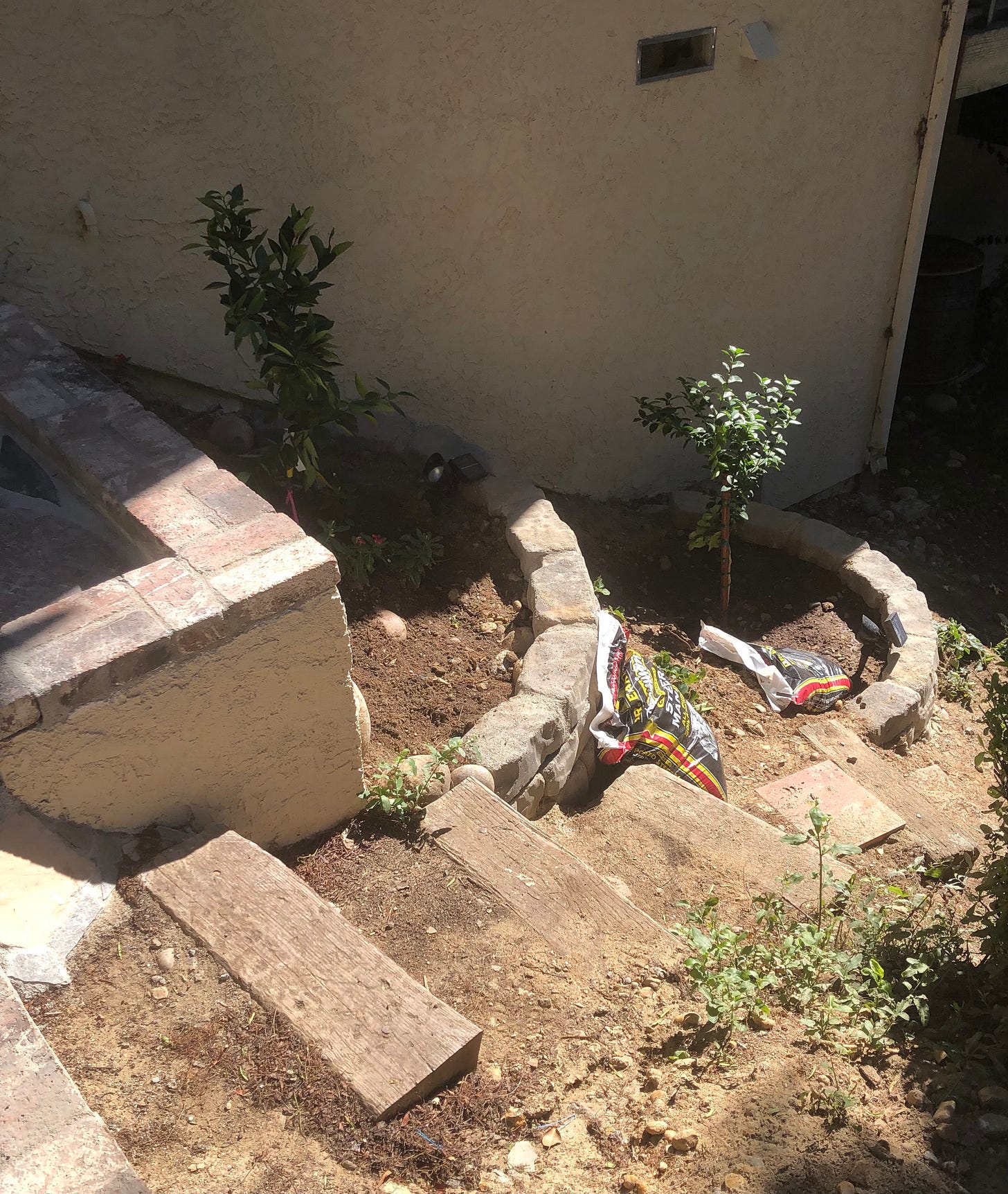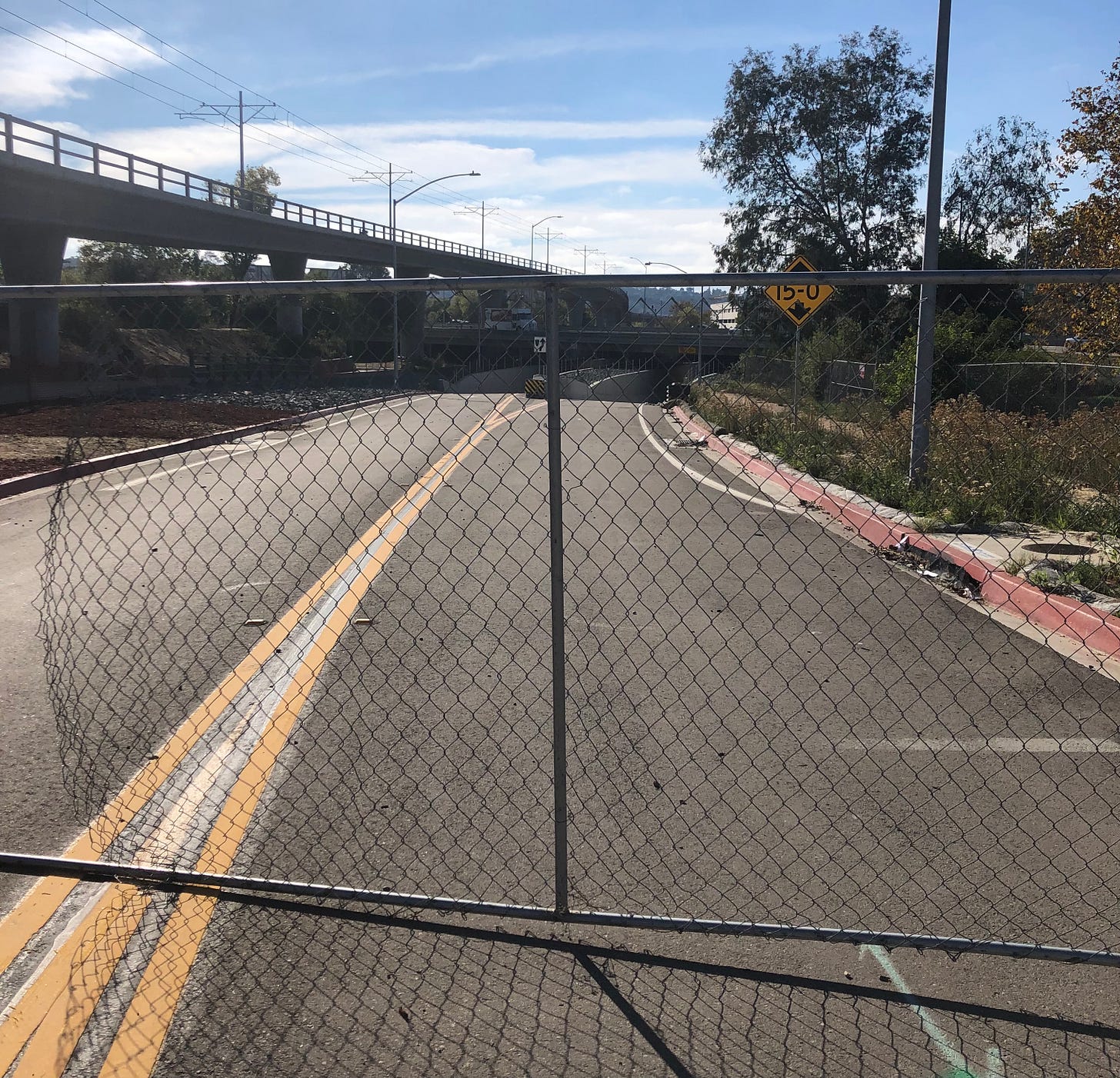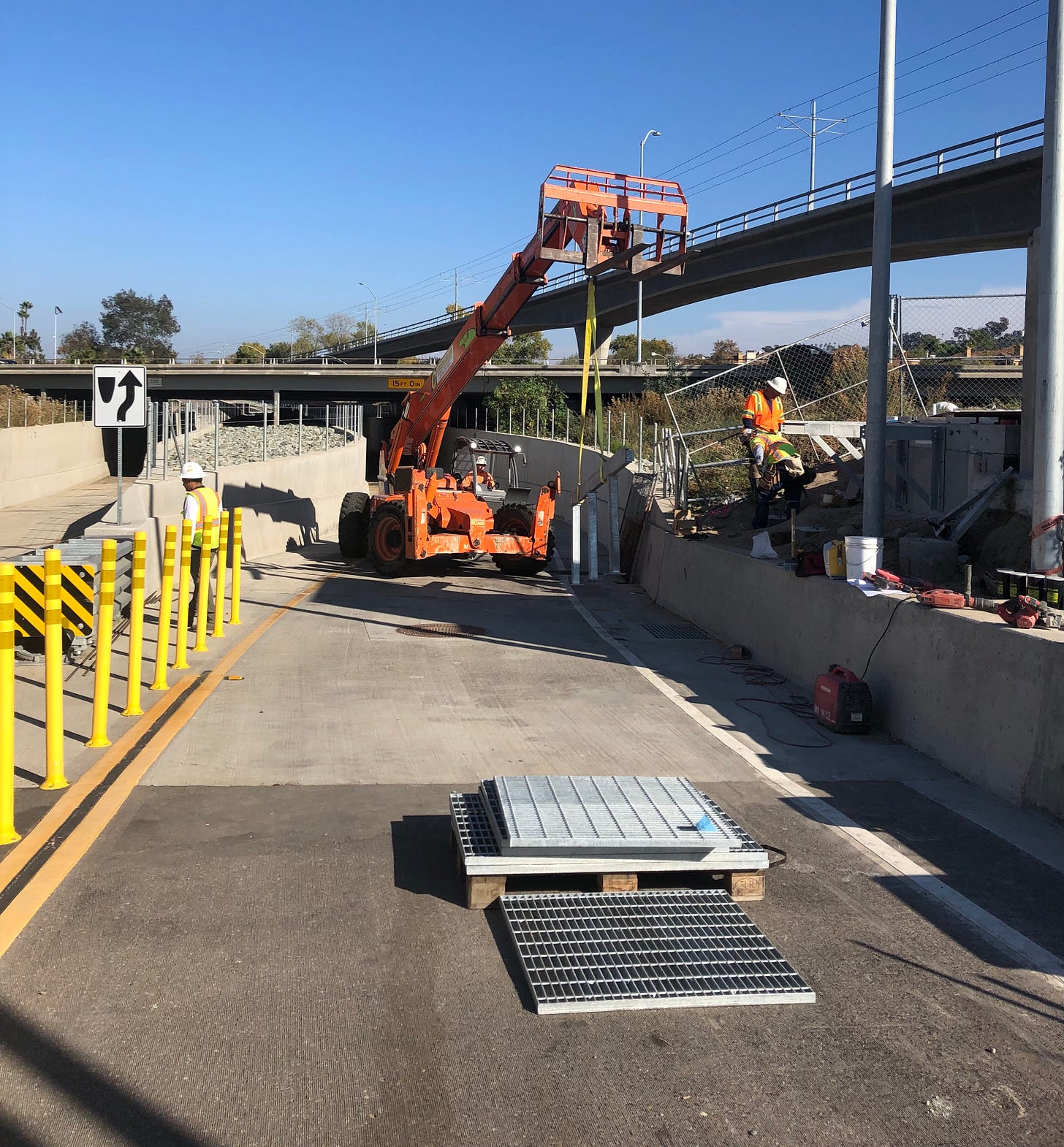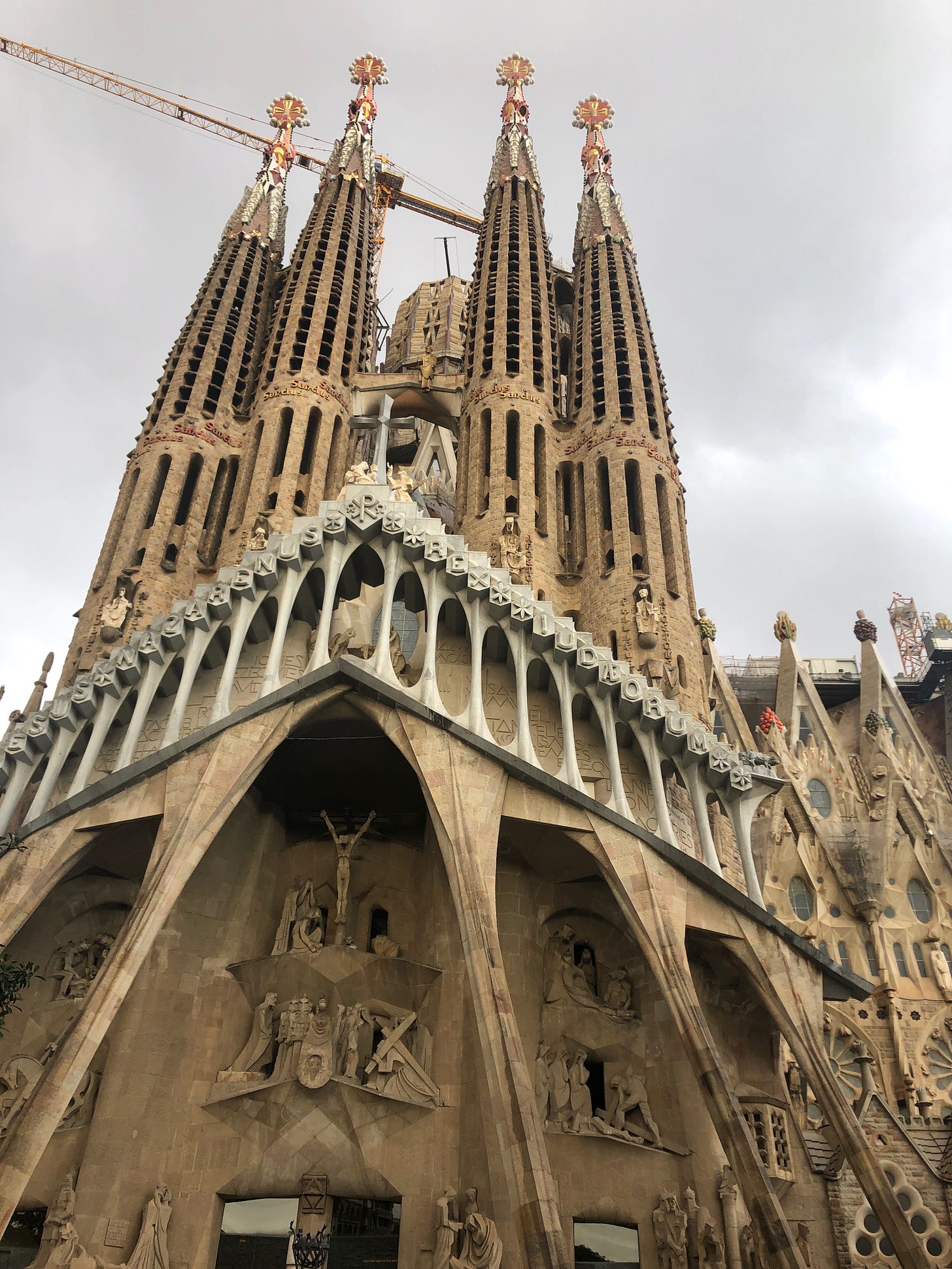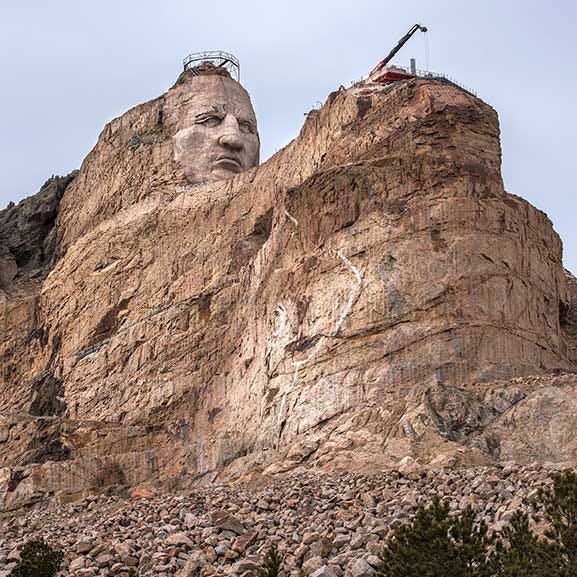Take a 2.1 Billion Dollar Worthy Ride
Plus: Revisiting Sushi Yorimichi in LV, Resident Challenges his HOA, News Brief, and Mission Valley Mystery Continues
Looking for something fun and interesting to do this weekend? Something that doesn’t involve fighting the Mission Valley holiday traffic? Or any traffic at all? If so, then I suggest you take advantage of San Diego’s brand new 2.1 billion dollar transportation marvel. Just head out to the new Tecolote trolley station off of Morena Boulevard and take a ride north on the new Blue Line Extension. You won’t have to worry about traffic congestion, parking hassles, or the price of gas, and you’re sure to enjoy the scenery.
The new Blue Line Extension opened up for business this past Sunday. Motivated by curiosity, we wasted little time taking a ride on the new trolley extension, going for a roundtrip this past Monday afternoon on a ride north that culminated with a stop at the UTC station, followed by a return to the nearby Tecolote station.
Here’s a list of some of some of the observations we made while taking the trip:
· There was plenty of convenient parking at the Tecolote trolley station.
· It was very easy to buy a ticket on the new Pronto ticket machines.
· A one-way ticket costs $2.50, though a senior ticket only costs $1.25.
· The first two stops (at Clairemont Drive and Balboa Avenue stations) are rather ordinary. You won’t see anything different from what you would by driving a car up Morena Boulevard. However, the elevated position of the trolley tracks allowed us to subsequently see the area between the Balboa Avenue and Nobel Drive stations from a different perspective than the one we’ve grown accustomed to seeing while driving to the La Jolla area on the familiar I-5 route. We saw commercial areas, open terrain, views of Rose Creek and parts of Rose Canyon from a refreshingly different angle, which allowed us to notice different and interesting details.
· The Nobel trolley station stops just yards away from the Whole Foods store. Of course, you can’t do too much shopping there while traveling on the trolley, since carrying heavy bags of grocery to and from the trolley station would prove too difficult, but hopping on and off the trolley for a little bit of shopping there (and taking in the free samples) would work out fine.
· We noticed the numerous UCSD students already using the trolley for transportation to and from the University campus. We also noticed how all the students used the MTS phone app to purchase and store their tickets. With our hard copy tickets dispensed from the Pronto ticket machine, we felt very old fashioned, and not unlike the characters in that Progressive Insurance commercial that mocks homeowners who have become like their parents. But we at least had the paper tickets readily available when the inspectors came aboard to check and see that everyone was properly ticketed!
· The elevated view from the trolley tracks allowed us to see how sprawling the UCSD campus is these days. That’s impossible to see from the lanes of I-5.
· We were glad to see that veterans have a new and efficient way to travel to the VA Hospital in la Jolla. The trolley makes a stop just a few yards away from this hospital.
· The trolley also makes a stop at the huge Scripps medical complex.
· The trolley grants easy access to the high-end UTC mall. There are elevators available for commuters to get to the mall’s entrance. If you like malls, or if you need to do some Christmas shopping and want to try something different from the Fashion Valley or Mission Valley malls, you now have this attractive option.
· The trolly ride from Tecolote station to the UTC station took a little over twenty minutes.
We hope you take the time to enjoy a ride on the trolley. See for yourself what 2.1 billion dollars will get you these days.
Some Sake or Asahi with Your Sushi?
I know what you are thinking. That we already reviewed Sushi Yorimichi— the still fairly new LV restaurant at 2405 Ulric St. You are right, but we have some exciting news. Sushi Yorimichi recently received its long awaited liquor license. Therefore, we felt it was our civic duty to pay a visit exclusively for the purpose of investigating to determine if they were now serving sake! Steve insisted that drinking sake would provide a more authentic Japanese cuisine experience.
On a recent Tuesday evening, we tore ourselves away from an exciting city redistricting Zoom meeting to begin our investigation.
The first thing I want to note is that although the establishment is small, all but one table was in use, so we quickly grabbed it. There also was a steady stream of people coming in for takeout. We took this to mean that our original review was spot on. This place has good food.
Besides perusing the menu, we also reviewed a separate sheet advertising their alcoholic drinks and there it was….along with the beer….different servings of sake. Hot large sake, large cold sake, small cold sake, and nigori sake. Prices were $3.50 small and $6.50 large.
Since we usually get sushi here (we are nothing if not predictable), this time around we decided to try something different. My hubby ordered Yakisoba with shrimp, and I opted for a curry rice bowl with shrimp cutlet. And although sake was what we came to investigate, Steve ended up ordering a bottle of Asahi beer ($4.00), claiming Japanese beer also provides for a more authentic Japanese cuisine experience. I got iced green tea ($2.00). I couldn’t drink alcohol since I had to get back to concentrating on the redistricting meeting.
Steve really enjoyed his Yakisoba. The noodles and vegetables were excellent and there was plenty of shrimp.
Our carnivorous sidekick had previously told us how much he enjoyed the rice curry (with meat of course) so I was anxious to try it with shrimp. It was sooo good. There were several pieces of shrimp cutlet on skewers with a large helping of rice and deep dark curry sauce. The curry was a little spicy but very tasty and the shrimp plentiful. I ended up sharing, as it was a large serving. I did notice the people at the next table enjoying their sake and even reordering it, so I am assuming it was good as well. Maybe next time I will try it. They have other interesting drinks, and even give free refills on their hot roasted green tea.
We were happy to see they were doing a brisk business. Service was very good and the server wore a mask. We urge you to visit this establishment. Enjoy a beer or some sake with your meal. And let them know you re-read about them in the Linda Vista Update.
HOA Rebel or Eco-Friendly Resident?
Is he an eco-friendly role model for his community, or just a nonconformist rebel? Fashion Hills resident Andy Stinson needs to convince his townhouse development’s homeowners association (HOA) that his recently completed (and expensive) residential project sets the example for helping to solve the property’s soil erosion problem and also encourages the proliferation of urban orchards. If not, Stinson, a well know fashion designer by profession, may find himself suffering the consequences for intruding upon the development’s common area—a big rule-breaking no-no in the world of HOA’s.
As more townhouse and condo housing developments spring up in the area (especially in Mission Valley), more and more people will find themselves dealing with the power of HOA’s. These resident-led organizations are responsible for making and enforcing the rules for their properties and fellow residents. The rules and their enforcement are meant to bring a sense of order in those planned communities designed to have residents share the same property, amenities, and aesthetics. Needless to say, critics of HOA’s complain that this emphasis on rules breeds too much mindless conformity along with a too restrictive atmosphere.
So, what happens when a resident takes it upon himself to break the rules of his HOA in the pursuit of what he/she considers a good idea? What happens when the good idea is an eco-friendly one with the potential to eventually help the entire community? And what happens when a resident boldly adopts a “better to ask for forgiveness than to ask for permission” type of attitude while pursuing his good idea?
This is the situation Fashion Hills resident Andy Stinson finds himself after building what he is calling a “rainwater management and erosion control channel” as well as an addition to his “urban orchard” on common property owned by the Fashion Hills HOA. In a development ruled by a HOA (and assisted by a property management company), common area consists of elements of a property available for use by all tenants or owners. In the Fashion Hills development—a Linda Vista community located on the rim of Mission Valley—those areas mainly consist of grassy spaces in between resident structures. Residents are not allowed to build/add any personal structures or other types of improvements that intrude on these common areas.
However, Stinson saw a need to take the initiative and solve a long-standing problem in the community pertaining to soil erosion and water intrusion. Due to the development’s hilly terrain, residents and landscapers have had to deal with rainwater eroding the land and causing flooding and structural damage to residences. He took action by focusing on the common area next to his own townhome (he considered this common area as long neglected by the HOA and its contracted landscaping company). Without asking for permission from the HOA, Stinson built a so-called “side yard design” outside his back fence that serves what he describes as “a comprehensive, rainwater management and erosion control channel.” This channel consists of a new, flagstone covered area adjacent to his residence. Some people may describe it as a patio or entertainment area, but he says it is designed to thwart the intrusion of water and mud that flows downhill into his backyard after a heavy rain. Stinson also added 3 fruit trees to the newly laid, flagstone ground cover as “a purposeful ploy in my design layout. Ingeniously they deliver a number of cleverly disguised, French drains; each designed to divert soil-eroding rainwater away from the surface and redirect it into the subsoil.”
Stinson now has 16 citrus trees in his back yard and side yard addition. He maintains that such urban orchards can play a role in “chewing-up the villainous and fast-growing numbers of air-borne carbon dioxide and carbon monoxide particles that increasingly pollute our air and oceans. Then, in-return, they spit-out life sustaining oxygen and water.”
Furthermore, Stinson is also quick to point out that San Diego County offers up tax incentives for property owners who maintain urban orchards.
Lastly, Stinson is proud that his project is very aesthetically pleasing, an improvement over what previously existed in that common area.
Stinson is scheduled to appear before the Fashion Hills HOA board of directors to make his case. They currently see his project as an unauthorized “entertainment center.” According to Stinson, he didn’t first seek permission from his HOA because he didn’t anticipate approval of such a novel idea. But now that it’s done and everyone can see it, he hopes the HOA board can buy off on the idea that such eco-friendly projects, if approved and implemented community-wide, could actually help cultivate a positive image of Fashion Hills as a place for eco-friendly homeowners.
Rebel or forward thinking? A classic clash of resident versus HOA. We will keep you informed on the fate of his project.
News Brief
—Mayor for a Day Contest
Please pass along this news to any aspiring young politico you may know:
Mayor Todd Gloria’s office is sponsoring a Mayor for a Day Contest. According to the mayor’s website, the contest “aims to foster and encourage leadership in young people living in San Diego. City of San Diego K-8th grade students are invited to write an essay or submit a video about how they would make the City of San Diego a better place if they were the Mayor. The selected winner will be given the opportunity to shadow the Mayor for a day.” Check out the contest website here to get details on how students can enter.
Commentary
The Mission Valley Mystery Continues through Holiday Season
Several months ago we featured an article about the Hazard Road Extension and how, for some mysterious reason, it’s opening has been long delayed. The extension begins from behind the Doubletree Hotel, under the 163 freeway, and over to the Fashion Valley Mall parking lot. Needless to say, the length of the extension is not that far. Construction for this road extension began in 2017. It has appeared to be ready for operation since 2019.
A few days ago, prompted by my thinking about the typical Friars Road traffic associated with the holiday shopping season and how it starts about this time of year, I went back to check on the road extension hoping it might now be open—just in time to handle all that holiday shopping traffic.
But no such luck! It was still closed, and it appeared the city was still working on its completion.
I asked the landscapers who were laboring at one end of the extension if they knew anything about the road being open soon. One of the landscapers, who was shoveling mulch next to the sidewalk leading up the extension, took time to comment, “I have been working in this area for five years and no one ever says when the extension will be open.” He shook his head and then went back to patiently unloading his mulch. Then I went to the other side of the road extension and asked a trio of construction workers using some heavy equipment to dig up dirt on one side of the road if they knew anything. One of them responded profoundly, “We don’t know when it will be open. We just know that it’s closed. Maybe we’re here to put the finishing touches.”
Instead of being discouraged about the road extension non-opening, I put my mind in positive mode and started to theorize about a possible long-term strategy that the City of San Diego might be conducting here. I concluded that perhaps this road extension is in fact being promoted as a mystery, realizing this unfinished and unopened road extension is in all likelihood part of a clever marketing ploy by the city’s tourist bureau. In other words, the city might not have ANY intention of finishing and/or opening this road extension. I know that sounds preposterous, but I’ve seen this style of marketing to tourists before.
For example, the famous Basílica de la Sagrada Família in Barcelona has been under construction for 139 years. Famous as the work of the architect Antoni Gaudi, this structural masterpiece is close to completion, but not quite there yet. Why has it taken so long to be completed? Who cares? The truth is the Basilica has become famous in spite of its long-delayed completion. Tourists flock to the Basilica, and it has been designated a UNESCO World Heritage Site. And tourists have to pay about $50.00 for the privilege of entering this site. Perhaps in not completing or opening the Hazard Road extension, the City of San Diego is hoping it too will be designated with some high honor. Maybe it will be promoted as a mysteriously quirky tourist site.
There is also the unfinished Crazy Horse Memorial located in South Dakota. This huge sculpture has been under construction since 1948 and is far from completion. If completed it will become the world’s second largest statue, but that’s a mighty big “if.”No matter, since on their way to the nearby Mount Rushmore National Memorial, tourists will often take the time to stop by and check out the Crazy Horse Memorial. They like the idea that it is not finished. Its non-completion is a weird mystery, and weird mysteries make for great, intriguing tourists venues.
So, let’s hope the Hazard Road Extension is open in time for this year’s Mission Valley holiday traffic. But if not, tell your out-of-state friends all about the mysterious road extension that was never completed or opened. They’ll want to pay a visit. The City can charge them big bucks to enter the site. And then we can call UNESCO headquarters and see what needs to happen for us to qualify an unfinished San Diego project for a World Heritage Site.
Happy Thanksgiving
We wish all of our readers a Happy Thanksgiving!
We at the Linda Vista Update are thankful to have so many thoughtful, dedicated readers!
Subscribe to the Linda Vista Update
If you haven’t already done so, please subscribe to the Linda Vista Update. It’s free! Just click on the below “Subscribe now” button. Once you do so, you will be on automatic distribution for all future posts. Join our growing readership.
The Linda Vista Update is a weekly digital newsletter that publishes informative, interesting and fun news about Linda Vista and its neighboring communities.

